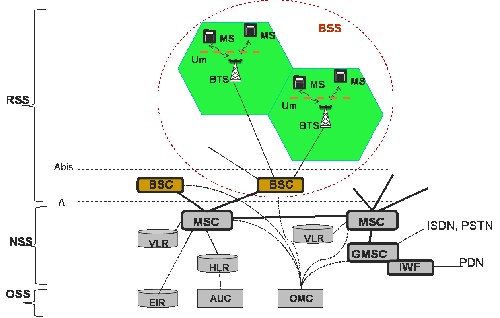GSM
Global System for Mobile communications (GSM) originally called Groupe Spécial Mobile is the first true standard for mobile phones in the world. GSM is being used by over 3 billion people across more than 212 countries and territories. Due to its wide deployment and international roaming between mobile phone operators subscribers can use their phones in many parts of the world. GSM offers digital signaling and speech channels and is considered a second generation (2G) mobile phone system.
CellularArchitecture
GSM is a cellular network, which means that mobile phones connect to it by searching for cells in the immediate vicinity.
There are five different cell sizes in a GSM network—macro, micro, pico, femto and umbrella cells. The coverage area of each cell varies according to the implementation environment. Macro cells can be regarded as cells where the base station antenna is installed on a mast or a building above average roof top level. Micro cells are cells whose antenna height is under average roof top level; they are typically used in urban areas. Picocells are small cells whose coverage diameter is a few dozen meters; they are mainly used indoors. Femtocells are cells designed for use in residential or small business environments and connect to the service provider’s network via a broadband internet connection. Umbrella cells are used to cover shadowed regions of smaller cells and fill in gaps in coverage between those cells.
Cell horizontal radius varies depending on antenna height, antenna gain and propagation conditions from a couple of hundred meters to several tens of kilometres. The longest distance the GSM specification supports in practical use is 35 kilometres (22 mi). There are also several implementations of the concept of an extended cell, where the cell radius could be double or even more, depending on the antenna system, the type of terrain and the timing advance.
Indoor coverage is also supported by GSM and may be achieved by using an indoor picocell base station, or an indoor repeater with distributed indoor antennas fed through power splitters, to deliver the radio signals from an antenna outdoors to the separate indoor distributed antenna system. These are typically deployed when a lot of call capacity is needed indoors, for example in shopping centers or airports. However, this is not a prerequisite, since indoor coverage is also provided by in-building penetration of the radio signals from nearby cell.
The modulation used in GSM is Gaussian minimum-shift keying (GMSK), a kind of continuous-phase frequency shift keying. In GMSK, the signal to be modulated onto the carrier is first smoothed with a Gaussian low-pass filter prior to being fed to a frequency modulator, which greatly reduces the interference to neighboring channels (adjacent channel interference).
Network structure
The network behind the GSM seen by the customer is large and complicated in order to provide all of the services which are required. It is divided into a number of sections and these are each covered in separate articles.
the Base Station Subsystem (the base stations and their controllers).
the Network and Switching Subsystem (the part of the network most similar to a fixed network). This is sometimes also just called the core network.
the GPRS Core Network (the optional part which allows packet based Internet connections).
all of the elements in the system combine to produce many GSM services such as voice calls and SMS.

